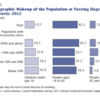I recently worked with three groups of eighth- and ninth-grade students. All of the groups are comprised of students of color from families in poverty, which means they qualify for free or reduced-price lunch under a California program whose cutoff is for a family of four is an income of under $30,615 (free), or under $43,568 (reduced-price). Students from families like these who qualify for free and reduced lunch are generally the students we talk about when we talk about children in poverty.
My three student groups all meet this criterion. In addition, they all are highly motivated and academically proficient, with supportive parents who have enrolled them in an after-school college-prep enrichment program. They must all be alike, right?
In fact, these three groups of students seem markedly different. The first is a racially diverse group that includes Latino/a, African-American, Pacific Islander and Indian students; several of the parents and many of the students’ older siblings have attended college, often very prestigious colleges....
...The second group lives in a very high-poverty community in South L.A. and attends a “no excuses” charter school in the neighborhood that is known for its rigorous academics and high test scores....
...The third group is from Compton and attends a district school that has struggled for years with low test scores and high suspension rates....
How do we measure differences like these?




Comments (0)